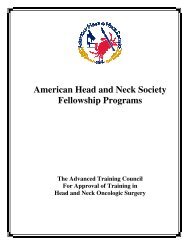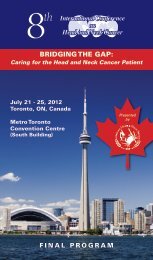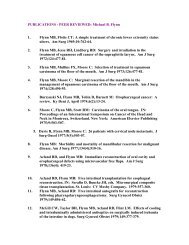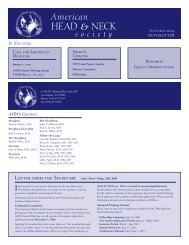Download - American Head and Neck Society
Download - American Head and Neck Society
Download - American Head and Neck Society
Create successful ePaper yourself
Turn your PDF publications into a flip-book with our unique Google optimized e-Paper software.
Oral Papers<br />
the most common cancers worldwide. Though advances in prevention<br />
<strong>and</strong> treatment have increased survival rates in other cancers, the 5-year<br />
survival rate for HNSCC patients, approximately 50%, has remained<br />
virtually unchanged for more than 30 years. In search of molecules with<br />
potential therapeutic benefit, we have conducted a comprehensive<br />
genomic <strong>and</strong> proteomic analysis of laser capture microdissected cancer<br />
<strong>and</strong> stromal cells from a large HNSCC frozen tumor collection from<br />
patients of distinct metastatic status. We observed that the expression<br />
of Vascular Endothelial Growth Factor C (VEGF-C) is a prominent feature<br />
in the most metastatic HNSCC lesions. VEGF-C is a member of VEGF<br />
family of growth factors <strong>and</strong> is most strongly identified with the process<br />
of lymphangiogenesis, or the growth <strong>and</strong> proliferation of the lymphatic<br />
vasculature. This observation prompted us to focus on the dysregulation<br />
of the lymphangiogenesis pathways in HNSCC. We have established<br />
rapid orthotopic models of HNSCC invasion in the tongue <strong>and</strong> intra-vital<br />
imaging approaches to monitor the process in live animals <strong>and</strong>, thus, are<br />
uniquely able to address the role of VEGF-C in the HNSCC metastasis.<br />
Using a lentiviral delivery system, we used two unique sequences of<br />
shRNA against VEGF-C to knockdown its release in OSCC3, a wellcharacterized<br />
cell line of high metastatic potential. We then injected<br />
these cells into SCID/Nod mice using our validated model of HNSCC<br />
metastasis, observing differences in tumor volume, metastasis <strong>and</strong><br />
vasculature density. In parallel, we characterized the effects of VEGF-C<br />
secreted by OSCC3 control <strong>and</strong> VEGF-C knockdown cells on the ability<br />
of lymphatic endothelial cells to proliferate <strong>and</strong> migrate. We aim to<br />
demonstrate that the release of VEGF-C by tumor cells is important for<br />
the process of lymphatic metastasis <strong>and</strong> VEGF-C signaling should be<br />
further investigated as a therapeutic target in HNSCC.<br />
S028<br />
SIGNIFICANCE OF CIRCULATING TUMOR CELLS IN PATIENTS<br />
WITH SQUAMOUS CELL CARCINOMA OF THE HEAD AND NECK.<br />
Kris R Jatana, MD, Priya Balasubramanian, MS, Jas C Lang, PhD, Liying<br />
Yang, PhD, Courtney A Jatana, DDS, Elisabeth White, BA, David E<br />
Schuller, MD, Theodores N Teknos, MD, Amit Agrawal, MD, Enver Ozer,<br />
MD, Jeffrey J Chalmers, PhD; The Ohio State University, Arthur G. James<br />
Cancer Hospital <strong>and</strong> Solove Research Institute.<br />
Objective: 1) To present <strong>and</strong> discuss a high performance negative<br />
depletion methodology for the isolation of circulating tumor cells (CTCs)<br />
in the blood of patients with squamous cell carcinoma of the head <strong>and</strong><br />
neck (SCCHN). 2) To begin to determine the correlation between the<br />
presence of CTCs <strong>and</strong> clinical outcome in SCCHN patients. Design:<br />
Prospective clinical follow-up study of SCCHN patients undergoing<br />
surgical intervention, who had peripheral blood tested for the presence<br />
CTCs using a negative depletion technique. Subjects: 30 patients<br />
diagnosed with SCCHN. Intervention: A negative depletion process to<br />
isolate <strong>and</strong> quantify CTCs from the blood of patients with SCCHN, using<br />
immunomagnetic separation was developed <strong>and</strong> validated. To date,<br />
this technique was performed on over 100 blood samples taken from<br />
patients at the time of surgery, <strong>and</strong> these patients have been followed<br />
in a prospective manner. Immunostaining for cytokeratin was performed<br />
on the enriched samples to determine the number of CTCs extracted<br />
from each patient’s blood sample. In addition, RNA was extracted from<br />
these enriched samples, <strong>and</strong> RT-PCR was used to determine if mRNA<br />
from EGFR was present. Correlation of CTCs, tumor stage, nodal<br />
status, EGFR status, <strong>and</strong> clinical outcome was made. Main Outcome<br />
Measure: Disease-free survival. Results: For the initial 30 patients, our<br />
data suggests that SCCHN patients with no detectable CTCs per mL<br />
of blood had a statistically significant higher probability of disease-free<br />
survival (p=0.03, mean follow-up=18 months). No CTCs were found in<br />
healthy human control blood samples. EGFR expression was present in<br />
62% of SCCHN patients with identifiable CTCs. In addition to cytokeratin<br />
markers, ongoing studies focus on using multicolor Confocal microscopy<br />
investigate the expression of other markers including “cancer stem<br />
cell” markers. Conclusions: An enrichment technology, based on<br />
the removal of normal cells, has been used on the peripheral blood of<br />
SCCHN patients for which outcome data is being collected. The data at<br />
this point indicates that this detection technology is potentially sensitive<br />
<strong>and</strong> specific enough to predict that if no CTCs were present, SCCHN<br />
patients had improved disease-free survival. A blood test with such<br />
a prognostic capability could have important implications in the<br />
management of SCCHN.<br />
www.ahns.info<br />
S029<br />
ENHANCED INVASIVE AND METASTATIC POTENTIAL OF CANCER<br />
STEM CELLS IN HEAD AND NECK SQUAMOUS CELL CARCINOMA.<br />
Samantha J Davis, BS, Vasu Divi, MD, John H Owen, BA, Silvana<br />
Papagerakis, MD PhD, Carol R Bradford, MD, Thomas E Carey, PhD,<br />
Mark E Prince, MD; Department of Otorhinolaryngology, University of<br />
Michigan, Ann Arbor, MI; Massachusetts Eye <strong>and</strong> Ear Infirmary/Harvard<br />
Medical School, Boston, MA.<br />
Objectives: Subpopulations of highly tumorigenic cells, or cancer stem<br />
cells (CSCs), have been identified within tumors of many types. These<br />
cells have the unique capacity to self-renew <strong>and</strong> produce differentiated<br />
progeny. In head <strong>and</strong> neck squamous cell carcinomas (HNSCC), the<br />
CSC population is contained within the cell fraction that expresses<br />
high levels of the surface molecule CD44. Although HNSCC CSCs are<br />
known to exhibit increased tumorigenicity compared to non-CSCs,<br />
it is unknown what role they may play in local invasion <strong>and</strong> distant<br />
metastasis. To explore this, we have designed both in vitro <strong>and</strong> in vivo<br />
models to study the behavior of this unique tumor cell subpopulation.<br />
Methods: In all experiments, cells were labeled with anti-CD44<br />
monoclonal antibody <strong>and</strong> sorted for CD44+ <strong>and</strong> CD44- fractions using<br />
flow cytometry. For in vitro studies, cells from three HNSCC cell lines<br />
(UMSCC-12, -14A, <strong>and</strong> -47) were serum-starved in media containing 1%<br />
FBS for 18 hours prior to sorting. The CD44+ <strong>and</strong> CD44- populations<br />
were plated in the upper chambers of Matrigel-coated <strong>and</strong> control<br />
inserts, with media containing 10% FBS <strong>and</strong> 30 ng/ml EGF in the lower<br />
chamber. Matrigel is a reconstituted basement membrane-like material<br />
<strong>and</strong> is well described as a tool for studying invasion. The chambers were<br />
incubated for 24 hours at 37°C. Cells remaining in the upper chamber<br />
were removed, <strong>and</strong> cells that had migrated to the lower chamber were<br />
fixed <strong>and</strong> stained. Cells were then counted using light microscopy.<br />
Results are expressed as percent invasion, calculated by dividing the<br />
number of cells that invaded through the Matrigel by the number of<br />
cells that migrated through the corresponding control insert. For in vivo<br />
study of CSC metastatic potential, CD44+ <strong>and</strong> CD44- cells from one<br />
primary tumor (HN-111) <strong>and</strong> one cell line (UMSCC-6) were injected into<br />
the tail veins of NOD/SCID mice. Lungs were harvested at six months<br />
to evaluate for the presence of metastasis. Results: In all three HNSCC<br />
cell lines, CD44+ cells were more invasive than CD44- cells. The increase<br />
in invasiveness ranged from 1.2 to 2.1-fold. UMSCC-12, a laryngeal SCC<br />
cell line, showed the greatest difference in invasion between the two<br />
populations. UMSCC-47, an HPV-positive tongue SCC cell line, showed<br />
an intermediate increase, while the floor-of-mouth SCC cell line UMSCC-<br />
14A showed the smallest increase in percent invasion (see Table 1).<br />
Three out of four mice injected with CD44+ cells <strong>and</strong> 0/4 mice injected<br />
with CD44- cells formed lung metastasis. Two of the metastasis arose<br />
from primary tumor CSCs injections <strong>and</strong> one from HNSCC cell line CSCs<br />
injections (see Table 2). Conclusions: An in vitro model of invasion<br />
<strong>and</strong> an in vivo model of metastasis to compare behavior of CD44+ <strong>and</strong><br />
CD44- cells support the hypothesis that CSCs have the unique capacity<br />
for progression of disease outside the primary tumor bed. Interestingly,<br />
CD44+ cells not only have greater ability to invade through reconstituted<br />
basement membrane, but they also migrate more efficiently through the<br />
control inserts. This phenomenon could be due to enhanced general<br />
mobility of CSCs compared to the general tumor population.<br />
41








